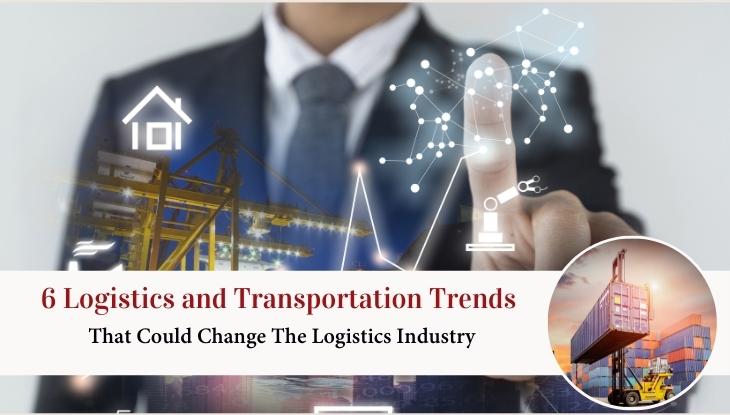The future for logistics and the transportation industry seems to be bright considering the trends that the industry is witnessing. With an expected global value of $12,975.64 billion in 2027, logistics is looking for technological catalysts to optimise the way it operates. It is true that the industry is prone to a lot of risks and leaking buckets. However, with upcoming technologies, they are likely to be gone or reduced by a significant margin. We are here to speak about these trends that have just entered or are likely to enter the transport and logistics scene in the near future.
Big Data
Data is indeed the new gold and a ‘data-heavy’ industry such as this relies heavily on proper data optimization to function properly. It is amazing to find that the intricacies of data management and processing in even the smallest transportation services is quite complex. Each and every truck is equipped with sensors and location trackers. Every booth and state line has their own set of documentation procedures. Then there are receipts and time sheets that have significantly been digitised.
To consolidate all this data and to make some real sense out of it requires strong and robust algorithms. The sole purpose of big data management here is to optimise the operations of even the smallest players in the transport and logistics industry.
Success stories from giants like DHL and UPS show the adoption of big data has resulted in:
Reduce and optimise fuel consumption.
Route optimisation which directly affects the usage of resources such as fuel.
Significant improvement in inventory management.
Reduced losses due to human error.
The success of big data in transport companies sydney and Brisbane and other logistic hubs of Australia is also a good example of how it is revolutionising the entire supply chain. It is the absolute necessity of places such as these to adopt big data because they are prone to natural disasters such as floods that disrupt the supply chain of the entire region.
Omni Channels
Omni channel shipping is a trend and a practice now adopted by almost all courier services and online marketplaces. The idea is to deliver a seamless experience to the customer.
When the digital age had not hit the world, the supply chain was terminated at the retail shops around the city. Transportation services also delivered the final product to the retail shops and their job was done. Only a few small and niche products such as milk and other consumables were delivered to the doorstep. This was done by the shopkeepers themselves.
The world has changed now and the ‘last mile’ is also being covered by service providers instead of customers. Everything can be delivered to your house – from medicines to groceries, from electronics to large furniture. Omni channel shipping is made possible by the joint efforts of various players such as manufacturers, freight forwarders, warehouse operators, and more.
One-way logistics is now a thing of the past. The complex new omni channel shipping has taken over the transport and logistics business.
RFID
Radio-frequency Identity or RFID has been around for quite some time now but logistics companies are adopting the technologies in new ways and implementing it in different ways. Also, smaller transport companies in Adelaide and Brisbane have started utilising RFIDs in scanners and receipt management. This technology is reliant on servers and in integrated file management tools.
RFID does add an additional cost angle to transport companies though. It is for this reason that many companies have taken their own time to understand the utility and then implement it. RFID tags as opposed to barcode scanners, for example, add as much as ten times to the expense of the company.
To get the best use of RFID based tools, it is important to find a middle ground. Transport companies need to use RFIDs in a manner that is suitable to their legacy operations as well.
Autonomous Vehicles
Autonomous vehicles and robots have been around for some time now and companies like Amazon have already used them in their warehouses. Again, it is the smaller players who are getting attracted to these vehicles that have a large initial investment but cover up for it in terms of human resources and manual labour. Autonomous vehicles in transport companies’ warehouses in Australia and other advanced countries are quite a normal sight now. Autonomous forklifts and drones have been helping logistic companies generate more efficient supply chains.
Autonomous ships have been the talk of the ‘logistics town’ in recent years. Rolls Royce has announced that they might launch autonomous cargo ships by 2030. Although a challenging endeavour with lots of risks involved, the results might be very profitable to the entire scenario.
Embedded Systems
Embedded systems coupled with cloud capabilities have been taking the logistics scene by storm. These allow a better consolidation and management of data collected by various sources. SaaS based solutions built around embedded systems can lower the risk factor by quite a margin. Interstate transport in large countries such as India and Australia can benefit a lot from this technology. First world countries are also using these to optimise their operations and to get a better ROI across channels.
One of the added benefits of utilising embedded systems is to provide customers with a direct advantage. Bi-directional communication between the transport company and the customer is a must and the realisation of this goal is indeed a huge step forward.
Optimised Logistics of Essential Goods
Revising and revisiting the supply chains that control the industries such as pharmaceuticals and FMCGs is taking precedence over everything now. The reason? COVID-19. Food, medicines, paper, and packaging need to be moved quickly as well as regularly. Breaks in the supply chain here can result in a butterfly effect that can disrupt deliveries for long periods. Transport logistics have realised this problem and have tweaked their operations over the pandemic to solve this problem.

